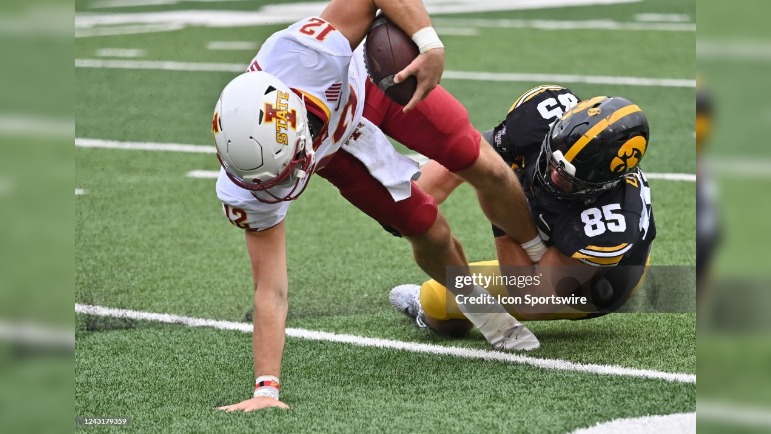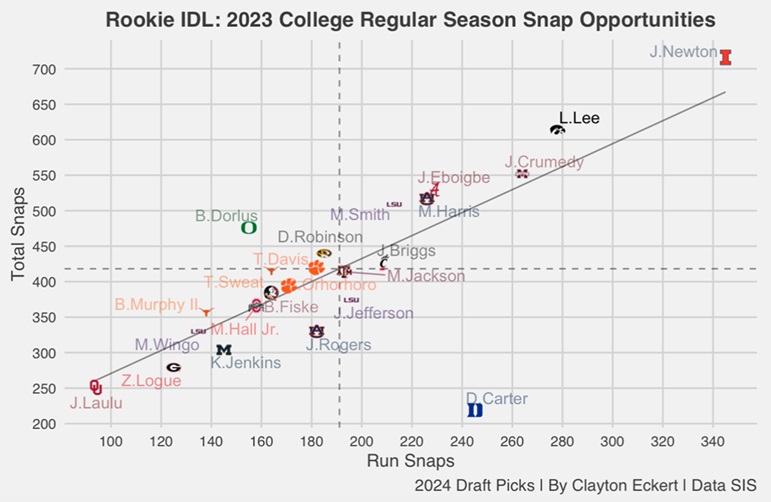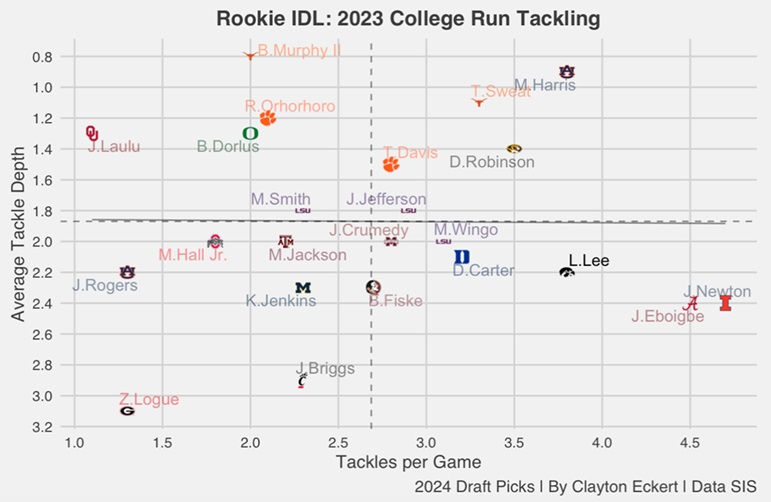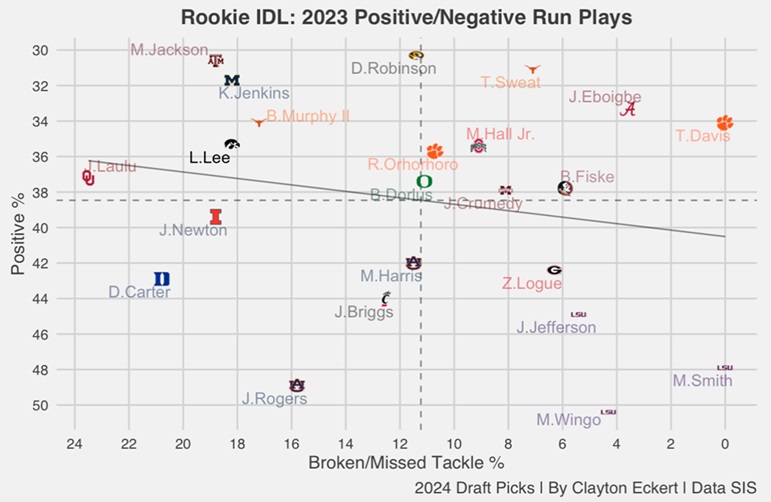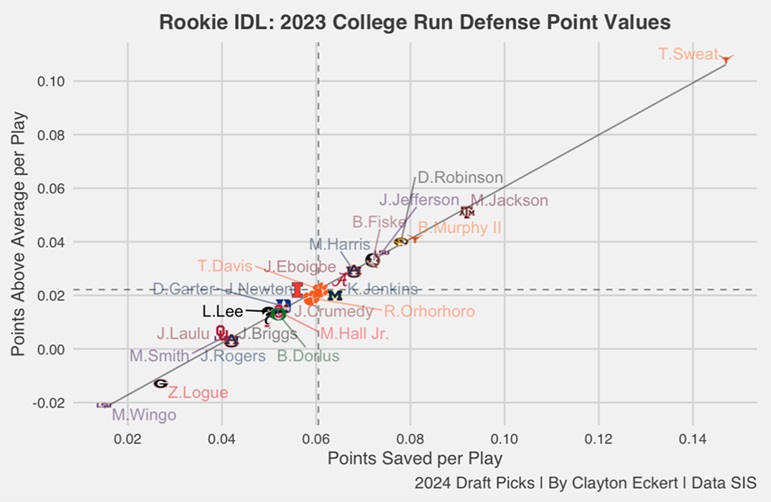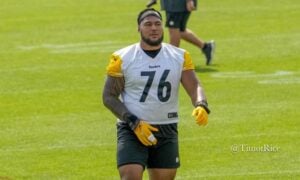Continuing the series, I wanted to move to the interior defensive line position (IDL), where the Pittsburgh Steelers selected Logan Lee in the sixth round. Today’s goal is to look at and provide stat context for the position in run defense using Sports Info Solutions (SIS).
The data in this study looks at their final college season in 2023, focusing on the players who heard their names called in the draft, and two players were excluded due to SIS not tracking smaller schools. The goal is to see how Lee stacked up among his peers.
With those things in mind, let’s start with rush snaps and total snaps to get a gauge of the players opportunities, and how often they were on the field for their squads last season:
Lee provided one of the highest snaps counts of the 23 qualifiers, with 614 total snaps and 278 run snaps, each ranking second, and notably higher than the majority of the 2024 IDL draft class. He started all 12 regular season games, providing durability in his 2023 campaign as the visual highlights, which is encouraging after dealing with injury earlier in his college career.
Next, let’s look at a very important aspect of being a quality run defender, tackling. The chart below looks at the players tackles per game and average tackle depth, with the latter suggesting quality play up front and attacking the line of scrimmage:
Starting with the good news, we see that Lee ranked high in tackles per game (3.8), which tied for third among the group. On one hand, that is to be expected with his high number of snaps, but that doesn’t automatically mean production. Thankfully, that is the case with Lee.
The other side of the coin was average tackle depth. While his 2.2 average doesn’t sound alarming, it tied for 16th out of the 23 players in our sights. IDL obviously play at the line of scrimmage and ideally make their run tackles there, or even better behind the line of scrimmage.
Of his 15 solo and 30 combined run tackles, four of those were tackles for loss. The data, and visual highlight this as a hopeful area of improvement for Lee in the NFL.
This next view attempts to weigh positive and negative plays, using broken and missed tackle rates (negative plays) along with SIS positive play % which is the rate of run plays with the player on the field resulted in a positive expected points added (EPA), with lower percentages being the best:
Landing on the top left of the chart, Lee had an above the mean 35.3 positive play rate, which ranked eighth-best. This means that when he was on the field, good things happened in the run game overall. Lee was a cog in a strong defense, which factors into the equation, but also played against some quality opponents that make his number an encouraging one.
Unfortunately though, there’s another flip side. Lee had one of the worst broken/missed tackle rates of the group, at 18.2-percent which tied for 18th. Six missed run tackles per SIS to be exact, which equates to one every two games played. Not what I expected to see going into the study, and will need to show he can improve to make the roster, and compete well at the NFL level.
To close, here is a more total view of the players in the run game:
- Points Saved per Play: The total of a player’s EPA responsibility on run plays using the Total Points system that distributes credit among all players on the field for a given play, with positive numbers being good. Totals are scaled up to map to the average points scored or allowed on a team level, with the player’s snap count determining how much to adjust. For run defense, that includes accounting for defenders in the box, blown blocks forced, broken tackles, turnovers, and turnover returns.
- Points Above Average per Play: using the same Total Points system and putting a number to their value above an average level player:
In this more total view, Lee lands below average in both data points in run defense. He tied for 15th in points above average, and 17th in points saved per play. So, not at the bottom of the barrel in terms of run defense in the 2024 IDL draft class, but we definitely see there being much to be desired.
So, the good news on Lee was an encouraging ability to stay on the field, ranking second in total and run snaps. He also had a presence in those opportunities making run tackles, tying for third most per game. Lee was also top ten in limiting positive plays (eighth-best), meaning when on the field for Iowa’s defense, things seemed to go well overall.
There were definitely weaknesses, and areas for Lee to hopefully improve as he begins his NFL journey. His below average marks were: points above average (T-15th), average tackle depth (T-16th), points saved per play (T-17th), and broken/missed tackle rate (T-18th) out of the 23 players in the study.
We definitely get a feel of Lee’s strengths and weaknesses in run defense his final college season. Here’s to hoping Pittsburgh can maximize his growth in these terms, which would pay huge dividends to their unit that needs more reinforcements behind Cam Heyward than the group was able to provide last season. I can’t wait to see if Lee can fit that mold.
Throughout the rest of the offseason, I will dive deeper into the data as we continue to learn about the newest Pittsburgh Steelers. Thanks for reading and let me know your thoughts in the comments.

